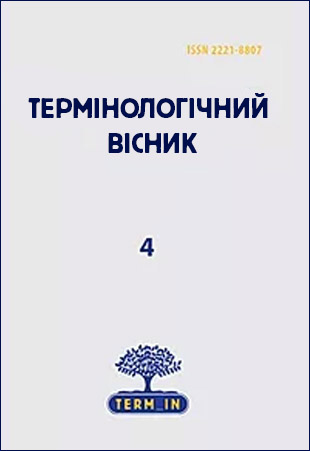Descriptional Metalanguage of Restrictive Syntaxemes as Component of Paremias

Founders
National Academy of Sciences of Ukraine,
Institute of Ukrainian Language of NAS
Publisher
Institute of the Ukrainian Language of National Academy of Sciences of Ukraine
Scientific journal Ukrainian Language is registered by the Ministry of Justice of Ukraine as print media (Certificate: Series КВ № 12180 – 1064 ПР of January 12, 2007).
Included in the list of printed scientific specialized editions of Ukraine (Order of MES of Ukraine no528 from 12.05.2015)
Back side of the journal
Maryna Pauk
Information about the author:
Deputy Director in educational work at Humanitarian Pedagogical College of Mukachevo State University (Mukachevo, Ukraine)
e-mail: pauk.oi@mail.ru.
Title: Descriptional Metalanguage of Restrictive Syntaxemes as Component of Paremias
Rubric: Terminology of Linguistic and Related Sciences
Abstract: Restrictive syntaxemes are an obligatory components of many Ukrainian proverbs. In the structure of sentences they are prepositive.
Linguists disagree about the criteria for selection of independent sentence disseminators. Multiple grammatical features of determinants that are considered by researchers do not cover the whole array of examples of determinants sentences, indicating the fundamental heterogeneity of the syntactic category of the sentence. Moreover, there is an opinion in linguistic literature that the determinant – is a myth, despite the fact that this concept is widely involved not only to the academic grammar but to manuals, textbooks.
Restrictive syntaxemes of proverbs have characteristic that allow them to refer to limitative determinants. We can formulate a definition of restrictive syntaxemes: they are some components that express situational space with the predication of a sentence. The role of restrictive component in the sentence meaning organization is that they not only qualify information about time, location, condition, etc., and establish spatial, temporal, contingent, subjective and other limits within which realize the situation, called a minimum scheme.
Prepositive restrictive syntaxemes as part of proverbs can be marked as limitative determinants and as topics. The last of these designations has the advantage of being able to attract to these syntaxemes not only formal secondary part, but the subjects.
Keywords: proverb, syntaxema, determinant, topic, dupleksyv.
References:
- Adamec, P. (1978). Obrazovanie predlozhenij iz propozicij v sovremennom russkom yazyke. Praha: Univ. Karlova (in Rus.).
- Arutyunova, N.D. (1979). Yazykovaya metafora (sintaksis i leksika). In Grigor’ev, V.P. (Ed.) (1979). Lingvistika i poetika (pp.147–173). Moscow: Nauka (in Rus.).
- Bricyn, V.M. (1990). Sintaksis i semantika infinitiva v sovremennom russkom yazyke. Kyiv: Naukova dumka (in Rus.).
- Shvedova, N.Yu. (Ed.) (1970). Grammatika sovremennogo russkogo literaturnogo yazyka. Moscow: Nauka, 1970( in Rus.).
- Dem’yankov, V. Z. (1979). «Sub”ekt», «tema», «topik» v amerikanskoj lingvistike poslednih let (Obzor 2). Izvestiya AN SSSR. Seriya literatury i yazyka. 1979,T. 38, № 4, 368 – 380.
- Zolotova, G.A. (1988). Sintaksicheskij slovar’. Repertuar elementarnyh edinic russkogo yazyka. Moscow: Nauka (in Rus.).
- Zolotova, G.A. (1973). Ocherk funkcional’nogo sintaksisa russkogo yazyka. Moscow: Nauka (in Rus.).
- Ivasiuk, S.H. (1998). Semantychni ta syntaksychni vlastyvosti limitatyviv u suchasnii rosiiskii movi [Synopsis of PhD thesis]. Kyiv (in Ukr.).
- Li Ch. &Tompson S. (1982). Podlezhashchee i topik: novaya tipologiya yazykov. In Kibrik, A.E. (Ed.). (1982). Novoe v zarubezhnoj lingvistike. Vyp. XI. Sovremennye sintaksicheskie teorii v amerikanskoj lingvistike. (pp. 193–235). Moscow: Progress (in Rus.).
- Malashchenko, V.P. (1991). Determinanty kak komponenty, oslozhnyayushchie strukturu predlozheniya. In Yazykovye edinicy v semanticheskom aspekte. (1991). (pp. 68–77). Taganrog (in Rus.).
- Malashchenko, V.P. (1978). Rol’ determinantov v formirovanii semanticheskoj struktury predlozheniya. In Semanticheskaya struktura predlozheniya. (1978). (pp.70–86). Rostov-na-Donu: Izd-vo Rostovskogo un-ta (in Rus.).
- Roslovec, Ya.I. (1976). O vtorostepennyh chlenah i ih sintaksicheskih funkciyah. Voprosy yazykoznaniya, 1976, № 3, 74–88 (in Rus.).
- Russkaya grammatika (1980).Vol. 2. Sintaksis. Moscow: Nauka (in Rus.).
- Beloshapkova, V.A. (Ed.) (1989). Sovremennyj russkij yazyk. Moscow: Vysshaya shkola (in Rus.).
- Bondarko, A.V. (Ed.) (1991). Teoriya funkcional’noj grammatiki: Personal’nost’. Zalogovost’. St. Petersburg: Nauka (in Rus.).
- Fomenko, Yu.V. (2001). Determinanty – real’nost’ ili mif? Vestnik Omskogo universiteta, 2001, № 3, 79–82 (in Rus.).
- CHejf, U.L. (1982). Dannoe, kontrastivnost’, opredelennost’, podlezhashchee, topiki i tochka zreniya. In Kibrik, A.E. (Ed.) (1982). Novoe v zarubezhnoj lingvistike. Vyp. XI. Sovremennye sintaksicheskie teorii v amerikanskoj lingvistike. (pp. 277–316). Moscow: Progress (in Rus.).
- Chernov, V.I. (1969). K voprosu o determinantah. Voprosy yazykoznaniya, 1969, № 1, 127–128 (in Rus.).
- Shvedova, N.Yu. (1964). Determiniruyushchij ob”ekt i determiniruyushchee obstoyatel’stvo kak samostoyatel’nye rasprostraniteli predlozheniya. Voprosy yazykoznaniya, 1964, № 6, 77–93 (in Rus.).
- Shvedova, N.Yu. (1973). K sporam o determinantah (obstoyatel’stvennaya i neobstoyatel’stvennaya determinaciya prostogo predlozheniya). Filologicheskie nauki, 1973, № 5, 66–77 (in Rus.).
- Shvedova, N.Yu. (1968). Sushchestvuyut li vse-taki determinanty kak samostoyatel’nye rasprostraniteli predlozheniya? Voprosy yazykoznaniya, 1968, № 2, 39–50 (in Rus.).


